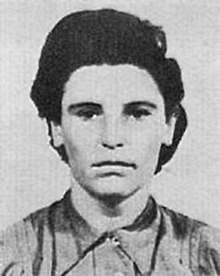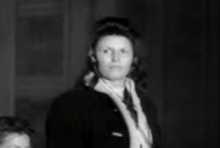Hildegard Lächert
Hildegard Martha Lächert (20 January 1920 – 1995) was a female guard, or Aufseherin, at several concentration camps controlled by Nazi Germany.[1] She became publicly known for her service at Ravensbrück, Majdanek and Auschwitz-Birkenau. After the war, she was sentenced to a total of 27 years in prison for her brutal treatment of inmates during her camp service, of which she served close to ten. She later worked for the Central Intelligence Agency (CIA) and for the West German spy agency the BND (Federal Intelligence Service).
Hildegard Lächert | |
|---|---|
 | |
| Born | 20 January 1920 |
| Died | 1995 (aged 75) |
| Occupation | Guard |
| Employer | Several German World War II concentration camps |
| Criminal charge | War crimes |
| Penalty | 27 years in prison |
In October 1942, at the age of 22, Hildegard Lächert, a German nurse, was called to serve at Majdanek as an Aufseherin. In 1944, after the birth of her third child, Lächert served at Auschwitz concentration camp. She fled the camp in December 1944 ahead of the advancing Red Army. There are reports that her last overseeing jobs were at Bolzano, a detention camp in northern Italy, and at the Mauthausen-Gusen concentration camp in Austria.
In November 1947, the former member of the Schutzstaffel (SS) appeared in a Kraków, Poland courtroom, along with 40 other SS guards in the Auschwitz trial. Lächert sat next to three other former SS women, Alice Orlowski, Therese Brandl and Luise Danz. Because of her war crimes at Auschwitz and Płaszów, the former guard and mother of two surviving children was given a sentence of 15 years in prison. Lächert was released in 1956 from a prison in Kraków. In 1975, the German government decided to try 16 former SS guards from the Majdanek concentration camp. Lächert was one of these, along with Hermine Braunsteiner and Alice Orlowski. From 26 November 1975 until 30 June 1981, the accused were tried in a Düsseldorf courtroom.

The testimonies heard concerning Lächert's sadistic behaviour were extensive and detailed. One former prisoner, Henryka Ostrowska, testified, "We always said blutige about the fact that she struck until blood showed," giving her the nickname "Bloody Brigitte" (Krwawa Brygida in Polish). Many other witnesses characterized her as the "worst" or "the most cruel" Aufseherin, as "Beast", and as "Fright of the Prisoners." For her part in selections to the gas chamber, releasing her dog onto inmates and her overall abuse, the court sentenced her to 12 years' imprisonment. She never had to serve this time, since her imprisonment in Poland (close to 10 years) and the time she spent in custody awaiting trial (5 years) were allowed for.
Hildegard Lächert died in 1995 in Berlin, aged 75.
Further reading
- G. Álvarez, Mónica. "Guardianas Nazis. El lado femenino del mal" (Spanish). Madrid: Grupo Edaf, 2012.ISBN 978-84-414-3240-6
References
- Álvarez, Mónica (2016-01-19). Se questa è una donna (in Italian). Edizioni Piemme. ISBN 9788858514740.
- Female Nazis, The Holocaust History Project, retrieved on August 17, 2016.
- Auschwitz Trial (November-December 1947), Jewish Virtual Library, retrieved on December 22, 2006.